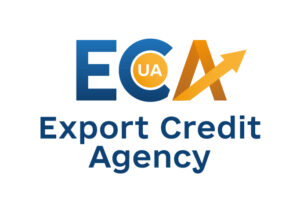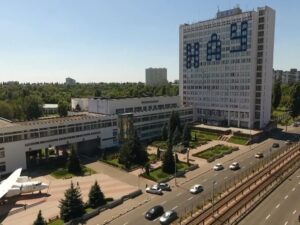
In December 2024, the Export Credit Agency (ECA) supported UAH 311.47 million of exports, bringing the total to UAH 7.5 billion since the beginning of the year.
According to the ECA website, the largest number of loans for exporters in December were issued and insured by Vostok Bank (UAH 175 million), Ukreximbank (UAH 43.8 million), and PrivatBank (UAH 40.7 million).
Entrepreneurs in Odesa region (UAH 174.8 million), Dnipropetrovs’k region (UAH 174.8 million), and Zakarpattia region (UAH 43.8 million) were the most active users of ECA services.
In December, Ukrainian exporters planned to trade with Latvia, Poland, and Uzbekistan the most: they will supply grain and flour products, paper and cardboard products, and toys.
In December, the ECA insured a bank guarantee for exports of services for the first time. It was provided by Ukreximbank to the Ukrainian company C.E. Industry Group, which won a tender for the repair of mining equipment of the Polish state-owned company Polska Grupa Górnicza S.A. The contract amount is UAH 43.78 million (PLN 4.25 million), the guarantee amount is UAH 17 million, and the validity period is 13 months.
The Export Credit Agency was established to stimulate the export of goods (works, services) of Ukrainian origin and support exporters-residents of Ukraine through insurance, reinsurance, and guarantees under security contracts for export development. On January 7, 2023, the National Bank of Ukraine was authorized to regulate the activities of the ECA.

The value of residential real estate in the euro area in the third quarter of 2024 increased by 2.6% compared to the same period a year earlier, according to the European Union Statistical Office (Eurostat).
In EU countries, the figure increased by 3.8%.
Only four countries recorded a decline in prices in annual terms, with the strongest declines in France (by 3.5%) and Finland (by 2.8%). The most significant increases were recorded in Bulgaria (by 16.5%), Poland (by 14.4%), and Hungary (by 13.4%).
In July-September, housing prices rose by 1.4% in both the euro area and the European Union compared to the previous three months. In the quarterly comparison, prices fell only in Finland (by 0.6%) and Estonia (by 0.5%), while the most significant price increases were recorded in Bulgaria (by 3.9%), Portugal (by 3.7%) and the Netherlands (by 3.6%).
For comparison, in the second quarter, housing prices in the euro area rose by 1.4% year-on-year, and in the European Union by 3%. Compared to the first quarter, prices rose by 1.9% in both regions.

Spanish authorities are planning to introduce a 100% tax on real estate purchases for non-EU residents. This measure is part of a plan presented by Prime Minister Pedro Sanchez aimed at overcoming the housing crisis and ensuring the availability of housing for local residents, the Financial Times reports.
The head of government said that EU non-residents annually buy 27 thousand residential properties in Spain, mainly “for the purpose of speculation”.
Spain is one of the European countries where public discontent is growing due to difficulties in finding affordable housing for purchase or rent amid a sharp rise in real estate prices and a significant lag between new construction and demand.
Over the past 10 years, housing prices in Europe have jumped by 48%, which is about twice the growth in household income over the same period, Sanchez said.
Spanish real estate is in high demand among people who buy vacation homes or want to move to a country with a warmer climate.
Such purchases are already subject to a number of taxes, the amount of which depends on the region and whether the transaction is on the primary or secondary market. In total, these taxes range from 7% to 12%.
Other measures proposed by the government include the transfer of more than 3,300 houses and approximately 200 hectares of land to a new state-owned company for the construction of social housing, stricter regulation of seasonal rentals, the restoration of empty buildings, and the provision of incentives to homeowners who rent out their homes at affordable prices.

Optima hotel chain (formerly Reikartz) opened the Optima Collection River Park hotel near Lubart’s castle in Lutsk on January 13.
According to the chain’s press service, the hotel has 86 rooms of the following categories: “Classic Single, Classic Twin, Classic Double, Standard, Superior, Superior MHN, Junior Suite and Suite. The hotel also offers two conference rooms and a meeting room. The hotel has a shelter for staff and guests during an emergency.
The Optima Hotels & Resorts chain unites more than 60 hotels in Ukraine. Until 2023, the chain was developing under the Reikartz Hotels & Resorts brand, and since 2020, with the help of Turkish shareholders, it has opened hotels in Kazakhstan, Georgia and Uzbekistan. In the summer of 2023, Turkish shareholders bought the Reikartz brand from a Ukrainian company for development in Turkey and Central Asia. In Ukraine, the hotel chain was rebranded in 2023 with the new name Optima Hotels & Resorts.
Optima Hotel Management LLC was established in 2008. According to Opendatabot, the company’s shareholders are Volodymyr Kashutin (Lviv, 99.9%) and Andriy Dema (Kyiv, 0.1%). Kashutin is listed as the ultimate beneficiary. At the same time, until 2019, the beneficiaries were Russian citizens Yuriy Vasin, Leonid Lavrentiev and Timur Rodionov.
According to the financial results for 2023, the company’s net profit amounted to UAH 7 million, compared to a loss in 2022. Revenue increased by 40.8% to UAH 445.8 million.

In 2024, the Ministry of Foreign Affairs and the State Service of Ukraine on Food Safety and Consumer Protection opened access to 16 new foreign markets for Ukrainian exporters, and the Ukrainian control system was recognized by key trading partners such as China, Canada, the United States, and EU member states, the press service of the State Service of Ukraine on Food Safety and Consumer Protection (State Service) reports.
“We understand that in times of full-scale war, it is critically important to support Ukraine’s economy, and in the face of challenges in the domestic market, exports are of particular importance. In fact, it is an opportunity to attract resources from outside the national economy and create opportunities for Ukrainian producers. Therefore, it is a strategic priority for us to help our companies enter new foreign markets. The Ministry of Foreign Affairs and the State Service of Ukraine for Food Safety and Consumer Protection act as the key that opens the door to trade. We negotiate with governments and partners on permits, certificates, trade liberalization, and admission of Ukrainian products. Last year, thanks to this work, we managed to open 16 new markets, and we plan to achieve new results in 2025,” said Andriy Sybiga, Minister of Foreign Affairs.
“The common goal of the State Food and Consumer Service and the Ministry of Foreign Affairs is to increase the export potential of Ukraine and its producers. And the results of 2024 show that we have succeeded. For example, our honey can now be exported to China, and egg products to Canada,” said Serhiy Tkachuk, Head of the State Service of Ukraine for Food Safety and Consumer Protection.
He added that Ukraine is currently working with more than 60 countries to enable Ukrainian producers to export their products of plant and animal origin.
The State Food and Consumer Service reminded that in 2024, Ukrainian producers gained access to foreign markets for 16 product groups in nine countries, including the Israeli market for poultry and fish flour, as well as oils and fats for animal feeding, China – for honey, Kuwait – for marine and river aquatic animals (fish, mollusks, crustaceans, needlefish, including those grown on farms), and the Kingdom of Bahrain – for poultry and poultry products, Bosnia and Herzegovina – for mechanically deboned poultry meat, Canada – for egg products, Albania – for meat products for human consumption and canned feed and chewing products for domestic animals, Moldova – for ungulates registered for breeding and user purposes, semi-finished poultry products, meat products and composite products, North Macedonia – for meat products. In addition, a veterinary health certificate was agreed upon to accompany reptiles to Israel.
The agency added that the certificate forms are published on the official web portal of the State Service of Ukraine for Food Safety and Consumer Protection in the section “International Cooperation” – “Veterinary and Safety” – “Certificates for Export from Ukraine”.
Currently, work is underway with international partners to expand sales of various commodity items, including poultry products, live cattle and small cattle, beef and pork, milk and dairy products, honey, apples, blueberries and cherries, peas and beans, onions, wheat flour, fish and fish products, and reproductive material.
“The Ministry of Foreign Affairs of Ukraine and the State Service of Ukraine for Food Safety and Consumer Protection will continue to work together to open new markets for Ukrainian exports, providing support to producers and eliminating technical barriers to trade, as well as providing state guarantees of compliance with the requirements of partner countries,” the ministry assured.
As reported, Ukraine has the right of access to export products in 360 trade directions of agricultural products. Over the past ten years, Ukraine has conducted more than 30 relevant international assessments.

The Trajectory Group wants to build two more 25-storey buildings on the territory of Kyiv Aviation University (KAI, formerly known as NAU), according to acting rector Ksenia Semenova.
“They are constantly bringing some additional agreements retroactively without signatures, which have no official trace within the university,” Semenova says.
Currently, the developer is building a four-section building on the corner of Garmatna Street and Vidradny Avenue. Two sections have already been put into operation, and two more are at the final stage of work, but construction has been stopped. Serhiy Klymenko, a representative of Trajectory, claims that the third and fourth sections of the building cannot be completed unless construction of two more 25-story buildings is started.
“This is illegal. Investors’ money cannot be used to complete other projects without their permission. Imagine that you invest in an apartment, and the agreement says that the money will not be used for its construction, but for the completion of another building. Would you buy it?” wrote Ksenia Semenova, acting rector of the KAI.
Summarizing, the acting rector noted that the university’s position is unchanged – no construction of residential complexes on the territory of the university. Service apartments are an unprofitable investment for the educational institution and the state, because land is an exhaustible resource. And the campus can only have infrastructure that facilitates the educational process.
The university is also interested in commissioning the third and fourth sections of the building. In particular, without further involvement of Trajectory Group.
Currently, the company has been asked to provide proposals for the completion of the construction and claims that in the absence of such proposals, the university will resolve the issue without their participation.
What is known about the construction
On September 14, 2021, the SACI issued a permit for the construction of apartment buildings on the land occupied by the NAU. According to the documentation in the electronic construction system, it was a residential complex of 14 nine-story buildings with 1659 apartments.
The area of the land plot on which the NAU campus is located is 38.2 hectares (according to the Land Cadastre). The customer for the construction of apartment buildings is NAU as the user of the land plot.
The rector since 2021 is Maksym Lutskyi, a former MP from the Party of Regions, who came to NAU during the rectorate of Mykola Kulyk in 2008-2015. That’s when the development of the university’s territory began. Maksym Lutskyi is associated with this development, as Vasyl Isaienko (rector of the National Academy of Sciences in 2016-2020) told Babel.
Atmosphere Engineering Systems was the general contractor of the new construction on the territory of the National Academy of Sciences. Until April 2020, one of the owners was Yevhen Petrishchuk, who was an advisor to the head of Ukravtodor Oleksandr Kubrakov from late 2019 to May 2021.
On April 29, 2024, the State Inspectorate of Architecture and Urban Development of Ukraine revoked the permit (registration number ІУ013210909218) for construction work on the territory of the National Aviation University. This was reported by the acting rector of NAU Ksenia Semenova.